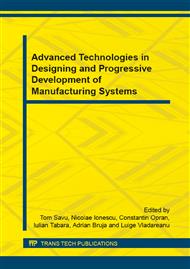[1]
S.C. Muresan, Researches regarding the mechanical strength of complex metal parts manufactured by selective laser melting, PhD Thesis, Technical University of Cluj-Napoca, (2012).
Google Scholar
[2]
V. Mager, Researches regarding manufacturing through selective laser melting of medical implants based on composite structures, PhD Thesis, Technical University of Cluj-Napoca, (2014).
Google Scholar
[3]
D. Wang, Y. Yang, X. Su, Y. Chen, Study on energy input and its influences on single track, multi-track and multi-layer in SLM., Int J Adv Manuf Technol 58, (2012), 1189–1199.
DOI: 10.1007/s00170-011-3443-y
Google Scholar
[4]
T.H.C. Childs, C. Hauser, M. Badrossamay, Selective laser sintering (melting) of stainless and tool steel powders: experiments and modeling, J Eng Manuf 219, (2005), 339–357.
DOI: 10.1243/095440505x8109
Google Scholar
[5]
X. Su, Y. Yang, D. Xiao, Z. Luo., An investigation into direct fabrication of fine-structured components by selective laser melting, Int J Adv Manuf 64, (2013), 1231–1238.
DOI: 10.1007/s00170-012-4081-8
Google Scholar
[6]
K. Alrbaey, D. Wimpenny, R. Tosi, W. Manning, and A. Moroz, On Optimization of Surface Roughness of Selective Laser Melted Stainless Steel Parts: A Statistical Study, JMEPEG 23, (2014), 2139–2148.
DOI: 10.1007/s11665-014-0993-9
Google Scholar
[7]
T. Itziar, G. Fermín, Z. Fidel, Z. Fidel, E. Aritz, Study of mechanical properties of AISI 316 stainless steel processed by selective laser melting, following different manufacturing strategies, Int J Adv Manuf Technol 51, (2010), 639–647.
DOI: 10.1007/s00170-010-2631-5
Google Scholar
[8]
S. Wen, S. Li, Q. Wei, Y. Chunze, S. Zhang,Y. Shi, Effect of molten pool boundaries on the mechanical properties of selective laser melting parts, Journal of Materials Processing Technology 214, (2014), 2660-2667.
DOI: 10.1016/j.jmatprotec.2014.06.002
Google Scholar
[9]
S. Bo, D. Shujuan, D. Sihao, L. Hanlin,C. Christian, Microstructure and tensile properties of iron parts fabricated by selective laser melting, Optics & LaserTechnology 56, (2014), 451-460.
DOI: 10.1016/j.optlastec.2013.09.017
Google Scholar
[10]
M. Roy, Vickers Hardness Measurements: Practices and Calibration Check, the University of British Columbia, Internal Technical Bulletin, v1. 0, July 22, (2010).
Google Scholar
[11]
ASTM-E384-10, Standard Test Method for Knoop and Vickers Hardness of Materials, revised in March (2010).
Google Scholar


